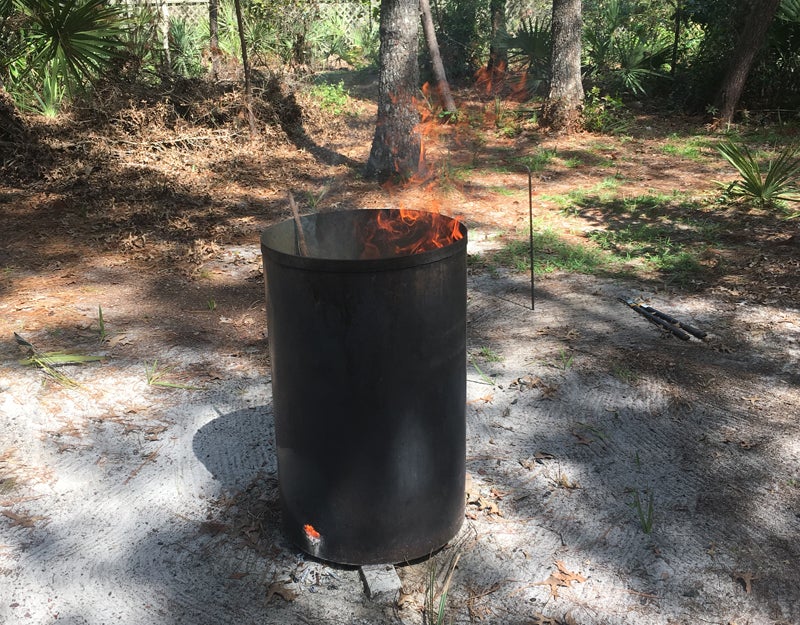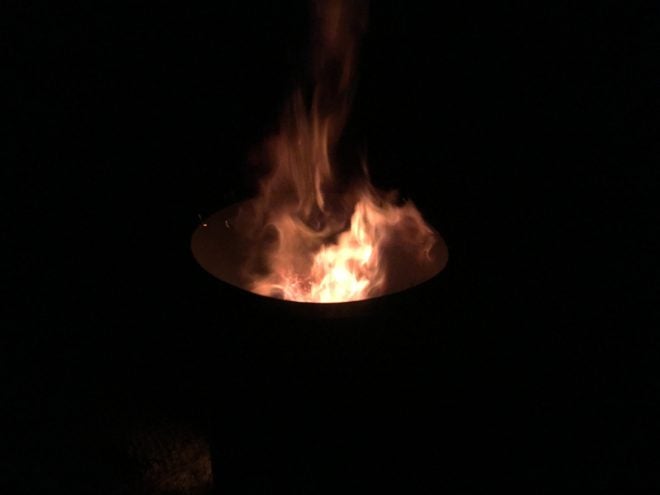Burn Barrel Benefits
Russ Chastain 10.16.17

I grew up in the country, and part of that meant we had trees, palmettos, and such, all of which produced stuff that needed to be burned. I helped Dad burn loads of limbs and leaves, and even wrapping paper after we opened our gifts on Christmas day. For much of the time, we just burned on the ground, but later on he got a nice barrel made of stainless steel, which lasted him for years and which I’m still using today.
Whether you’re burning trash or yard debris, a barrel can make your life a lot easier, and in some areas it’s the only way to burn legally.
I have numerous trees on my small country property, and between thunderstorms, bark beetles, gravity, and hurricanes that means I have a lot of burnable stuff to dispose of. Burning is one of the best ways to do that, but burning on the ground is not nearly as efficient as using a barrel. The barrel helps contain the material AND the fire, which helps concentrate the heat and accelerate the burn. The natural movement of air through one or more holes low in the side of the barrel also helps things to burn more quickly.
Unlike when you burn on the ground, there’s a bit more need to trim limbs into smaller hunks. This is a little more work, but it beats walking around a fire pit feeding in the ends of burnt-off limbs. Once you cut it and toss it in the barrel, you’re done with it.
Like everything else, burn barrels have limitations. I can’t feed mine a lot of leaves without mixing in sticks to keep a hot bed of coals in the drum and prevent the leaves from building up and smoldering. This can be a problem without a barrel, too. I usually don’t burn leaves; instead I spread them on our dirt road to help prevent dust and erosion.
You don’t want your burn barrel to sit right on the ground. Some air space is helpful below it, and this helps prevent the bottom from rusting out of steel barrels. I just use three bricks on mine. Some folks use concrete blocks.
You want at least one (preferably two or three) good-size air holes near the bottom of the barrel. Keep them clear while you burn; you want air flowing in through those holes during the burn.
Some folks put holes in the bottom of the barrel, but I do not and I don’t recommend it. This will accelerate rust-through and doesn’t help much for drainage when you have a bed of ashes in the barrel. The air holes should be low on the barrel anyhow, and this will let out rain water in the event that you forget to cover the top.

Yep — it’s a good idea to keep the barrel covered when it’s not hot. This keeps rain out, which means your drum will be dry when it’s time to burn something and also helps prevent rusting. Our cover is just a hunk of old corrugated aluminum roofing which Dad bent and tossed on his barrel decades ago; it’s still working fine.
Something that can help (and which is required in some areas) is a metal grate that you can cover the barrel with during the burn, to help contain hot embers. When the fire is burning strongly, it’s drawing air through the vent holes and the barrel is acting like a chimney of sorts; this means the rising heat can carry lightweight burning materials (leaves, paper, etc) up and out of the barrel. The grate helps contain that so your fire doesn’t spread.
And that’s another thing I like about a burn barrel: it helps keep the fire contained so it’s less likely that the fire will get away from you, especially if you leave it unattended. That said, you do want to keep dry leaves and other flammables away from your barrel so hot embers, including those which may dribble out of the vent holes. Don’t start a fire outside of the drum.
Ashes do build up inside and must be removed after they fully cool, but it’s amazing how much you can burn in a barrel before the ashes get too high. If all you burn is wood and paper products, these ashes can be used to enrich garden soil or even to make soap if you are truly old-school.
Dad and I have burned truckloads of stuff in the old burn barrel, and it doesn’t show any signs of wearing out. Most burn barrels are made of steel 55-gallon drums, and rust eventually will get to them. Thankfully, they’re still making steel drums and they can usually be obtained pretty cheaply.
Get yourself a burn barrel; you won’t be sorry.